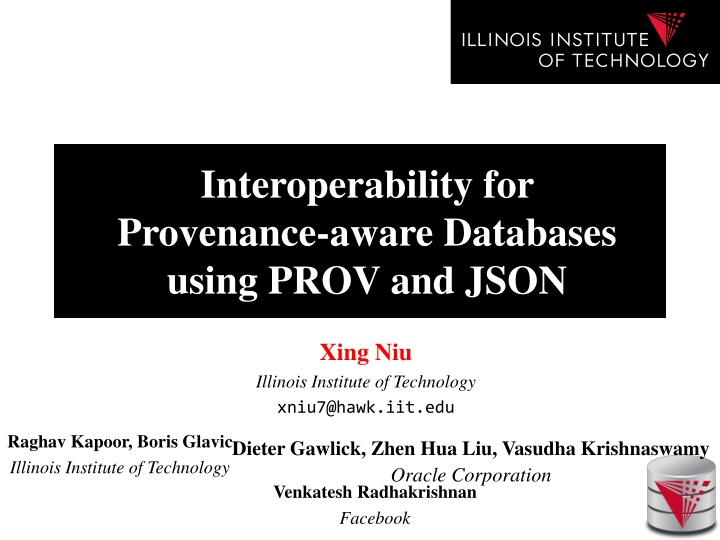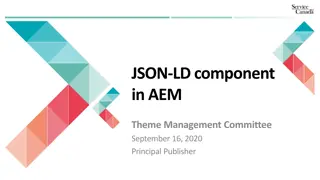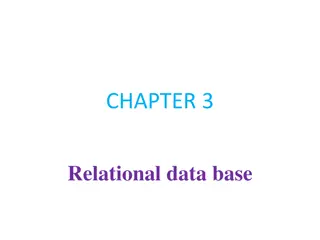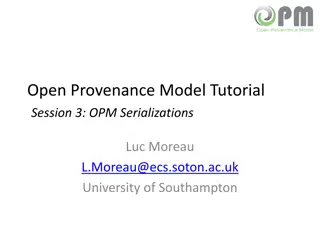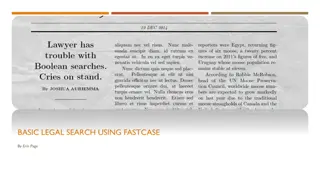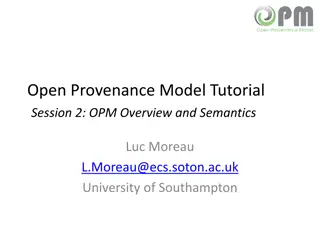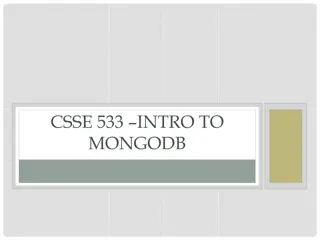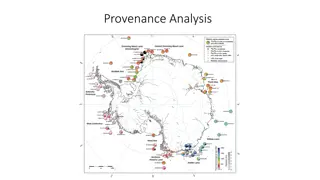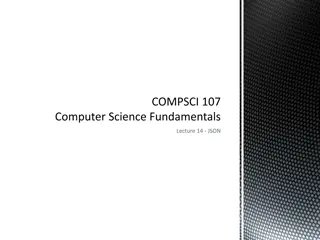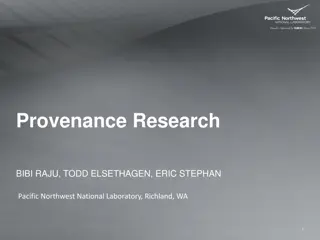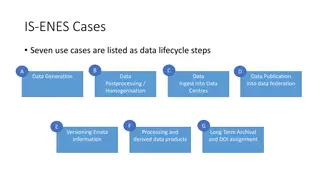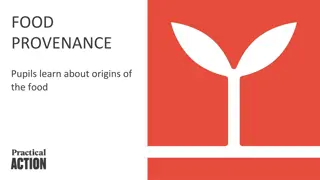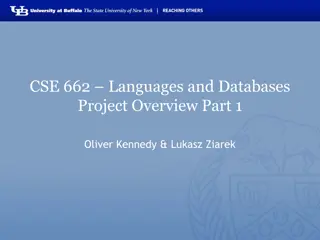Interoperability for Provenance-aware Databases Using PROV and JSON
This research paper discusses the challenges in tracking database provenance and proposes a system, GProM, that computes provenance for database operations. It highlights the importance of exchanging provenance information between systems and the limitations of current relational database systems in exporting provenance in standardized formats like PROV. The paper presents examples and experimental results, emphasizing the need for interoperability in provenance-aware databases.
Uploaded on Sep 29, 2024 | 1 Views
Download Presentation

Please find below an Image/Link to download the presentation.
The content on the website is provided AS IS for your information and personal use only. It may not be sold, licensed, or shared on other websites without obtaining consent from the author.If you encounter any issues during the download, it is possible that the publisher has removed the file from their server.
You are allowed to download the files provided on this website for personal or commercial use, subject to the condition that they are used lawfully. All files are the property of their respective owners.
The content on the website is provided AS IS for your information and personal use only. It may not be sold, licensed, or shared on other websites without obtaining consent from the author.
E N D
Presentation Transcript
Interoperability for Provenance-aware Databases using PROV and JSON Xing Niu Illinois Institute of Technology xniu7@hawk.iit.edu Raghav Kapoor, Boris Glavic Illinois Institute of Technology Dieter Gawlick, Zhen Hua Liu, Vasudha Krishnaswamy Oracle Corporation Venkatesh Radhakrishnan Facebook
Outline Introduction Related work Overview Export and Import Experimental Results Conclusions and Future Work
Introduction The PROV standards A standardized, extensible representation of provenance graphs Exchange of provenance information between systems Provenance-aware DBMS Computing the provenance of database operations E.g., Perm[1], GProM [2], DBNotes[3], Orchestra[4], LogicBlox[5] [1] B. Glavic, R. J. Miller, and G. Alonso. Using SQL for Efficient Generation and Querying of Provenance Information. In In Search of Elegance in the Theory and Practice of Computation, pages 291 320. Springer, 2013.. [2] YB. Arab, D. Gawlick, V. Radhakrishnan, H. Guo, and B. Glavic. A generic provenance middleware for database queries, updates, and transactions. In TaPP, 2014. [3] D. Bhagwat, L. Chiticariu, W.-C. Tan, and G. Vijayvargiya. An Annotation Management System for Relational Databases. VLDB Journal, 14(4):373 396, 2005. [4] G. Karvounarakis, T. J. Green, Z. G. Ives, and V. Tannen. Collaborative data sharing via update exchange and provenance. TODS, 38(3):19, 2013. [5] Huang, S., Green, T., Loo, B.: Datalog and emerging applications: an interactive tutorial. In: SIGMOD, pp. 1213 1216 (2011) 3
Introduction Example: extracting demographic information from tweets 4
Introduction Problem: No relational database system supports tracking of database provenance as well as import and export of provenance in PROV Not capable of exporting provenance into standardized formats E.g., GProM: Essentially produces wasDerivedFrom edges Between the output tuples of a query Q and its inputs. However, not available as PROV graphs No way to track the derivation back to non-database entities 5
Introduction GProM System Computes provenance for database operations Queries, updates, transactions Using SQL language extensions e.g., PROVENANCE OF (SELECT ...) 6
Introduction Example of GProM in action The result of PROVENANCE OF for query Q Each tuple in this result represents one wasDerivedFrom assertion E.g., tuple to1 was derived from tuple t1 7
Introduction Goal: make databases interoperable with other provenance systems Approach: Export and import of provenance PROV-JSON Propagation of imported provenance Implemented in GProM using SQL 8
Outline Introduction Related work Overview Export and Import Experimental Results Conclusion and future work
Related Work How to integrate provenance graphs by identifying common elements? [6] Address interoperability problem between databases and other provenance-aware systems through Common model for both types of provenance [7][8][9] Monitoring database access to link database provenance with other provenance systems [10][11] [6] A. Gehani and D. Tariq. Provenance integration. In TaPP, 2014. [7] U. Acar, P. Buneman, J. Cheney, J. van den Bussche, N. Kwasnikowska, and S. Vansummeren. A graph model of data and workflow provenance. In TaPP, 2010. [8] Y. Amsterdamer, S. Davidson, D. Deutch, T. Milo, J. Stoyanovich, and V. Tannen. Putting Lipstick on Pig: Enabling Database-style Workflow Provenance. PVLDB, 5(4):346 357, 2011. [9] D. Deutch, Y. Moskovitch, and V. Tannen. A provenance framework for data-dependent process analysis. PVLDB, 7(6), 2014. [10] F. Chirigati and J. Freire. Towards integrating workflow and database provenance. In IPAW, pages 11 23, 2012. [11] Q. Pham, T. Malik, B. Glavic, and I. Foster. LDV: Light-weight Database Virtualization. In ICDE, pages 1179 1190, 2015. 10
Outline Introduction Related works Overview Export and Import Experimental Results Conclusion and future work
Overview We introduce techniques for exporting database provenance as PROV documents Importing PROV graphs alongside data Linking outputs of SQL operations to imported provenance for their inputs Implementation in GProM offloads generation of PROV documents to backend database SQL and string concatenation 12
Outline Introduction Related works Overview Export and Import Experimental Results Conclusion and future work
Export and Import Export Added TRANSLATE AS clause e.g., PROVENANCE OF (SELECT ...) TRANSLATE AS Construct PROV-JSON document from database provenance Running several projections over the provenance computation E.g., _:wgb\( || F0.STATE || | || F0. AVG(AGE) || \) Uses aggregation to concatenate all snippets of a certain type E.g., entity nodes, wasGeneratedBy edges, allUsed edges Uses string concatenation to create final document 14
Export and Import Example: part of the final PROV document Red dotted lines in DB 15
Export and Import Import Import PROV for an existing relation Provide a language construct IMPORT PROV FOR ... Import available PROV graphs for imported tuples and store them alongside the data Add three columns to each table to store imported provenance prov doc: store a PROV-JSON snippet representing its provenance Prov_eid: indicates which of the entities in this snippet represents the imported tuple Prov_time: stores a timestamp as of the time when the tuple was imported 16
Export and Import Import Relation user with imported provenance Attribute value d is the previous PROV graph without database activities and entities example 17
Export and Import Using Imported Provenance During Export Include the imported provenance as bundles in the generated PROV graph Bundles [13] enable nesting of PROV graphs within PROV graphs, treating a nested graph as a new entity. Connect the entities representing input tuples in the imported provenance to the query activity and output tuple entities [13] P. Missier, K. Belhajjame, and J. Cheney. The W3C PROV family of specifications for modelling provenance metadata. In EDBT, pages 773 776, 2013. 18
Export and Import Example of Bundles: 19
Export and Import Handling Updates If a tuple is modified, that should be reflected when provenance is exported E.g., by running an SQL UPDATE statement Example Assume the user has run an update to correct tuple t1 s age value (setting age to 70) before running the query 20
Export and Import Challenge How to track the provenance of updates under transactional semantics Solution GProM using the novel concept of reenactment queries User can request the provenance of an past update, transaction, or set of updates executed within a given time interval Construct PROV document using provenance for updates computed on-the-fly 21
Outline Introduction Related works Overview Export and Import Experimental Results Conclusion and future work
Experimental Results TPC-H [14] benchmark datasets Scale factor from 0.01 to 10 (10MB up to 10GB size) Run on a machine with 2 x AMD Opteron 3.3Ghz Processors 128GB RAM 4 x 1 TB 7.2K RPM disks configured in RAID 5 Queries Provenance of a three way join between relations customer, order, and nation With additional selection conditions to control selectivity (and, thus, the size of the exported PROV-JSON document). [14] TPC. TPC-H Benchmark Specification, 2009. 23
Experimental Results 1 GB 10 GB 24
Outline Introduction Related works Overview Export and Import Experimental Results Conclusions and Future Work
Conclusions and Future Work Conclusions Integrated import and export of provenance represented as PROV-JSON into/from provenance-aware databases Construct PROV graphs on-the-fly using SQL Connect database provenance to imported PROV data Future Work Full implementation for updates Automatic storage management (e.g., deduplication) for imported provenance Automatic cross-referencing 26
Questions My Webpage http://www.cs.iit.edu/~dbgroup/people/xniu.php Our Group s Webpage http://cs.iit.edu/~dbgroup/research/index.html GProM http://www.cs.iit.edu/~dbgroup/research/gprom.ph p 27
Others Provenance querying Provenance for JSON 28
